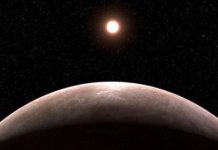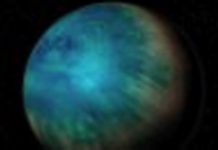
Feb. 27 (UPI) — Astronomers have found a large exoplanet that could have the right conditions for life.
After analyzing the mass, radius and atmosphere of K2-18b, located 124 light-years from Earth, scientists determined the exoplanet’s surface could host liquid water.
The habitability of K2-18b, which boats is 2.6 times the radius and 8.6 times the mass of Earth, expands the search for alien life to planets significantly larger than Earth but smaller than Neptune.
Scientists previously detected water vapor in the hydrogen-rich atmosphere surrounding K2-18b, but until now, astronomers weren’t sure whether the exoplanet was capable of hosting liquid water on its surface.
“Water vapor has been detected in the atmospheres of a number of exoplanets but, even if the planet is in the habitable zone, that doesn’t necessarily mean there are habitable conditions on the surface,” lead researcher Nikku Madhusudhan, a scientist at Cambridge University’s Institute of Astronomy, said in a news release.
“To establish the prospects for habitability, it is important to obtain a unified understanding of the interior and atmospheric conditions on the planet — in particular, whether liquid water can exist beneath the atmosphere.”
If K2-18b was more like Neptune than Earth, it would likely feature a layer of high-pressure water vapor inside an envelope of hydrogen. The inside of a mini-Neptune would likely feature an inner core of rock and iron. If the hydrogen envelope was too thick, the temperature and pressure at the water layer would be inhospitable to life.
The latest research, published this week in the online journal arXiv, suggests this is not the case. After closely studying the atmosphere, mass and radius of K2-18b, researchers deployed a variety of numerical models and statistical methods to predict the makeup of the exoplanet’s atmosphere and interior.
“We wanted to know the thickness of the hydrogen envelope — how deep the hydrogen goes,” said co-author Matthew Nixon, doctoral student at the Institute of Astronomy. “While this is a question with multiple solutions, we’ve shown that you don’t need much hydrogen to explain all the observations together.”
The analysis showed there were a range of possibilities to account for the data they had collected, but that the biggest the hydrogen envelope could be is around 6 percent of the planet’s mass — not to big to overwhelm life. In some of the scenarios produced by the modeling efforts, the water layer surrounding K2-18b boasts pressures and temperatures similar to Earth’s oceans.
In addition to confirming the presence of a hydrogen-rich atmosphere and water vapor around K2-18b, scientists also found methane and ammonia were lower than expected. However, researchers can’t say whether biological processes are responsible for the diminished concentrations.
Astronomers on the lookout for habitable worlds have mostly focused on Earth-like exoplanets, but the latest findings suggests the search should be expanded to include bigger, Neptune-like worlds such as K2-18b.





